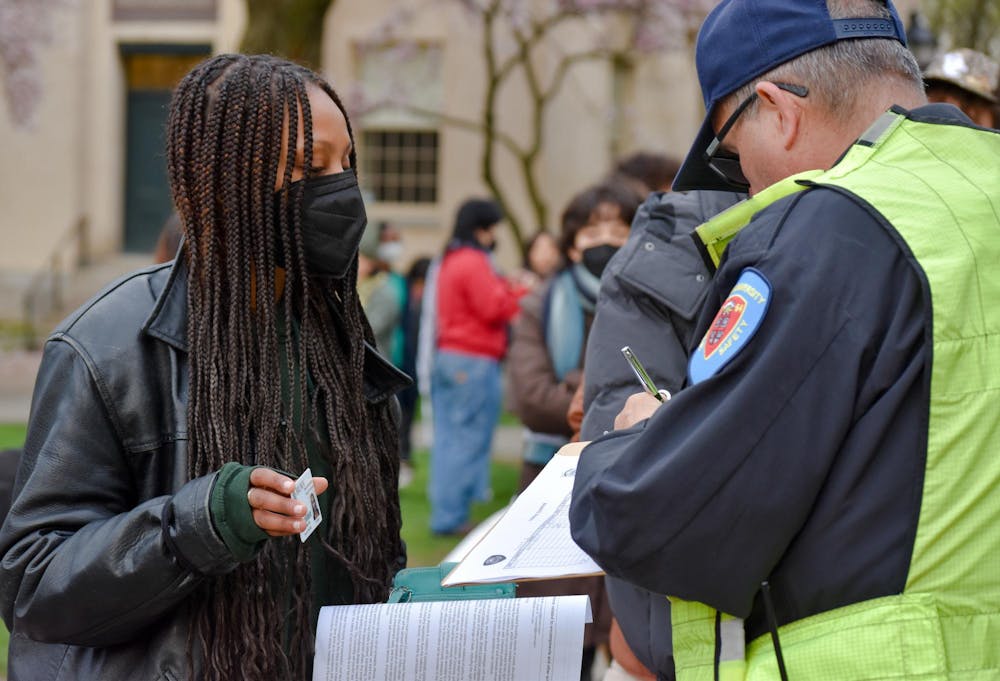On April 23, Vice President for Public Safety and Emergency Management Rodney Chatman and other members of the Department of Public Safety were aware of an imminent pro-Palestinian encampment set to begin the next morning.
According to emails and texts reviewed by The Herald, DPS obtained a document outlining protesters’ plans for the encampment the evening before it began, with Chatman sending it to officers across DPS and the Providence Police force. As tents were pitched on the Main Green on April 24, officers were ready to greet the students.
How DPS obtained the document remains unclear.
Four sources with direct knowledge of the creation and distribution of the document accuse Brown of acquiring the document by monitoring their school-owned Google Drive data, an allegation that the University has denied. It is also possible that one of the hundred-plus students with access to the document provided it to the University.
The sources, who were granted anonymity for fear of retaliation for creating a document condoning arrestable offenses, used the document during a series of interest meetings they held with prospective encampment participants.

Following the meetings, a link to the Google document was sent via an encrypted messaging platform to each interested individual. The original document, which The Herald reviewed, was hosted on personal Google accounts, but it was accessible to anyone with the link, including those with Brown accounts.
This vulnerability, sources said, could have permitted the University to view the document.
Brown policy allows certain administrators to authorize access to documents, spreadsheets, emails and “data stored in Brown funded or contracted cloud services” over the course of “Brown University investigations,” among other instances.
Three people with knowledge of DPS’s internal operations told The Herald that they were aware of instances of online monitoring, but they were not directly involved in any of those processes. The sources were granted anonymity for fear of retaliation from the University.
“In the infrequent circumstances that would require an authorized individual at Brown to access protected electronic information for purposes related to investigative, safety or emergency preparedness,” University Spokesperson Brian Clark wrote in an email to The Herald, “it would not be appropriate for us to share details with news media.”
But he added that “accessing protected electronic information to seek details on organizing or advocacy efforts among community members” would not adhere to the University’s policy for accessing protected electronic materials, such as documents and emails.
“Protest and demonstration are an acceptable means of expression on campus,” he added, “provided those activities do not interfere with the normal functions of the University or infringe on the rights of others.”
The document distributed by Chatman was in the form of a Microsoft Word file. According to the document’s metadata, that copy was created by Chatman himself.
The dissemination of this briefing document was similar to the process the activists used for two sit-ins protesting the University’s decision not to consider an endowment divestment proposal from companies affiliated with Israel.
In a review of emails between DPS and Providence Police, neither were knowledgeable of plans for arrestable offenses until the sit-ins began.
To prepare for possible encampment activity at Brown, Chatman also distributed police reports from other universities’ law enforcement offices describing protest activity on their respective campuses to DPS and members of Providence Police.
The encampment briefing document
The briefing document itself provides a glimpse into student activist groups’ private thinking before the encampment.
In private, University officials were reserving arrests as a last resort for the student protests, with Chatman telling Providence Police, “Brown leadership is expressing the preference of addressing the policy implications rather than law implications,” The Herald previously reported. But as the students were negotiating with Brown representatives, DPS was planning for mass arrests, with the impression that the encampment “will likely need to end at some point this week.”
Still, arrests were an outcome student activists were expecting. “On Wednesday morning at 5 a.m., 150+ people will walk to the Main Green, pitch tents and remain there until arrest,” the document reads. The actual number of participating students began at around 80 before rising to 112 at peak participation.
The briefing document also requested the students be prepared not only for arrest but for suspension. “If you have paid tuition for a semester when you are suspended,” the document reads, “you will lose your money.”
This doomsday scenario was in line with past organizing. A spokesperson for the Brown Divest Coalition — the student activist group who organized the encampment — told The Herald they make an effort “to prepare for the worst-case scenario” in response to any actions they take.
Student activists were also explicitly aware that the encampment was a violation of University policy. “Tents are not allowed to be set up on the Main Green,” they wrote in the document. The activists were also conscious of Brown’s event policy that requires registration of the event two weeks prior to its start — clearance they did not have.
A BDC spokesperson said that the participants “knew the risks” of organizing the encampment, “but, ultimately, speaking out against our university’s investments in the genocide and scale of violence ongoing in Gaza far outweighed any potential disciplinary measure from the university.”
Activists originally asked for all participants to commit to a 72-hour encampment. But in their public communications, the encampment participants said that there was no deadline for the end of their demonstration: They boasted plans to stay on the Main Green until the University divested from companies affiliated with Israel.
In response, a BDC spokesperson said in a statement that the document’s language reflected their “best guesses” of a “potential response from the University informed by months, if not years, of campus organizing.”
“As the encampment began, we evidently changed course from this initial language as we remained committed to staying until we saw movement on our demands,” the statement added.
Imploring students to join them in April, the document called the encampment “the first step toward imagining a new, truly liberatory kind of university. This moment will certainly go down in history: let’s be part of that story.”
After one week, the encampment disbanded under an agreement that the Corporation, the University’s highest governing body, vote on a divestment proposal. The Corporation ultimately voted not to divest Brown’s endowment from companies activists say are affiliated with Israel.

Owen Dahlkamp is the managing editor of newsroom on The Herald's 135th Editorial Board, overseeing the paper's news operations. Hailing from San Diego, CA, he is concentrating in Political Science and Cognitive Neuroscience with an interest in data analytics. In his free time, you can find him making spreadsheets at Coffee Exchange.





